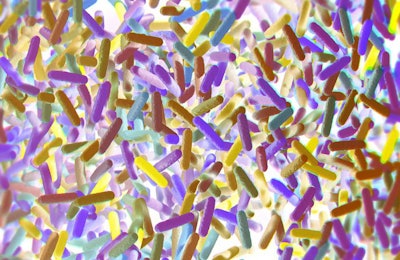
The surface area of a dog's intestines covers more than enough space for a good game of fetch. Among all the interesting snippets of information about pet’s microbiomes, Richard Murphy, Ph.D., research director for Alltech European Bioscience, finds not only the range of microorganisms astounding, but also the size of the gastrointestinal tract’s surface area. All that habitat allows a complex community of bacteria and other organisms to live in animals' intestines. All that complexity leads to a great deal of variation between species and individuals.
“What's important to remember is that it can be quite hard to define what a normal or a typical microbiome is,” Murphy said in a Petfood Industry on-demand webinar.
Watch “Understanding the link between pet health and the Microbiome.”
When that complex microbial community shifts out of balance, the gut can fall into a state called dysbiosis. This unhealthy microbiome correlates with chronic inflammation and digestive problems.
The gastrointestinal tract and the microbiome change as dogs, cats and other pets age, making dysbiosis more common, Rebecca Delles, Ph.D. said in the webinar. For example, the lining of older dogs’ intestines tends to become less efficient at absorbing nutrients as the size of the guts’ villi, or tiny protuberances, become smaller. Likewise, dysbiosis becomes more common as aging guts lose microbial richness and beneficial bacteria. Catering to the needs of older pets’ guts and their microbes may help address some of the declines that come with advancing years.
“Diet can play a key role when we're talking about trying to mitigate this type of chronic inflammation that typically occurs in the aging process,” she said. “What we can do from a pet owner standpoint is to try and support a healthy gut microbiota, biota, and a healthy aging process at the same time. And to do that, we as researchers need to understand what is going on when we feed these dogs, this type of diet, and how does that affect inflammation and ultimately dysbiosis.”
Pet food prebiotics effects on dog health
Pet food formulators have a diverse range of gut health products, Murphy said, including probiotics, enzymes, prebiotics and plant extracts. Alltech has focused on pet gut health products isolated from yeast cell walls, called mannan oligosaccharides. The company refines these yeast products into another, known as mannan rich fractions (MRF).
To test the effects of diet on dogs’ gut microbes, Alltech researchers fed mature Beagles a control diet or a kibble formulated with an MRF-based product, NVGEN. In fecal samples from the feeding trial, dogs in the prebiotic group had larger proportions of beneficial bacteria, including Faecalibacterium. Likewise, populations of Turicibacter were higher in the guts of dogs fed the control diet, as well as higher levels of a chemical signature of chronic inflammation, called c-reactive protein, with 14 milligrams per liter in their blood. What’s more, while normal healthy levels of that chemical in dogs are lower than 12 milligrams per liter, Beagles fed the prebiotic diet had levels at nearly 9 milligrams per liter.
“We know that these different generation [mannan oligosaccharides] products can actually rebalance the gut and micro flora,” Delles said. “Ultimately, this is due to the fact that you can enhance positive microbial diversity, reducing the pathogen load, ultimately reducing inflammation in a manner that can improve that healthy aging process of these animals.”


















